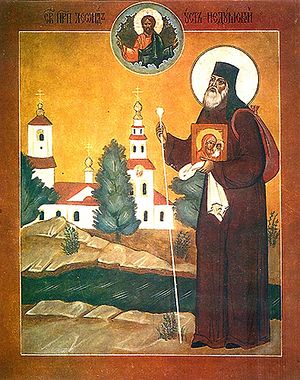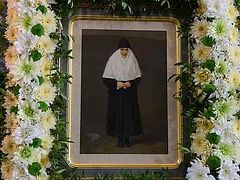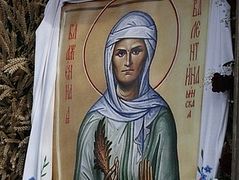Ozer, Kirov Province, Russia, June 24, 2019
 In February 2016, the Holy Synod of the Russian Orthodox Church more than 30 locally-venerated saints for Church-wide veneration, among them St. Leonid of Ust-Neduma.
In February 2016, the Holy Synod of the Russian Orthodox Church more than 30 locally-venerated saints for Church-wide veneration, among them St. Leonid of Ust-Neduma.
Desiring to uncover the blessed one’s relics for the consolation and strengthening of the faithful, archaeological work was undertaken in February-March of last year in the Church of the Entrance of the Mother of God in the village of Ozer in the Kirov Province, which had been built by St. Leonid himself and where it was known that he had been buried in 1654, specifically with the blessing of His Holiness Patriarch Kirill to uncover the saint’s relics.
The place of St. Leonid’s burial has always been revered by locals and attracted many pilgrims, and many miracles and healings have occurred at his tomb. Notes from the Vologda Diocese from 1884 report that lightning the struck the church, damaging the iconostasis and the columns supporting the canopy over his grave, and other documents attest that the tomb over his grave was preserved until 1932, though the faithful did not subsequently forget about St. Leonid and the place of his burial during the long years of godless communism and persecution.
The excavation work was carried out by a local cultural heritage center, and the remains found were transferred for a forensic medical examination, which confirmed that the remains are the relics of St. Leonid.
On June 18, Pat. Kirill blessed the veneration of the relics of St. Leonid, which will soon be available for veneration in the Entrance of the Mother of God Church.
***
St. Leonid’s biography from the site of the Orthodox Church in America:
St. Leonid of Ust-Neduma lived in the Poshekhonsk district of Vologda, and he was a farmer by occupation. At age fifty, he saw the Mother of God in a dream, Who directed him to go to the River Dvina to the Morzhevsk Nikolaev hermitage. He was to take from there the Hodigitria Icon of the Mother of God, and build a church for it at the River Luz and Mount Turin.
St. Leonid decided not to follow the advice of this vision, thinking it simply a dream, and considering himself unworthy. He went to the Kozhe Lake monastery, accepting monastic tonsure there and spending about three years at work and ascetical efforts. From there he transferred to the Solovki monastery and labored there in the bakery.
The miraculous vision was repeated, and St. Leonid was advised not to oppose God’s will. The venerable one then set off to the Morzhevsk hermitage, and after a year he told Igumen Cornelius (1599-1623) about the command of the Mother of God. Having received from the abbot both a blessing and the Hodigitria icon, the monk reached the River Luz near Mount Turin, 80 versts from the city of Ustiug, and he built himself a hut from brushwood. The local people, fearing that their land would be taken from them for the saint’s monastery, compelled him to resettle up the river in a marshy wilderness spot.
At 30 versts from the city of Lalsk, the Elder constructed a cell and set about building a monastery. For draining the marshes, the ascetic dug three canals, about 2 kilometers in length, from the River Luz to Black Lake, and from Black Lake to Holy Lake, and from there to the Black Rivulet. During this time of heavy work he was bitten by a poisonous snake. Entrusting himself to the will of God, St. Leonid decided not to seek medical treatment, nor did he think of the consequences. He went to sleep and woke up healthy. In gratitude to the Lord for His mercy, he called the canal the “Nedumaya Reka” (“Unplanned River”), and his monastery the “Ustnedumsk” (“the mouth of the Nedumaya”) monastery.
With the blessing of the Metropolitan Philaret of Rostov (afterwards the Patriarch of All-Russia, 1619-1633), St. Leonid was ordained hieromonk in 1608. In the newly-built church in honor of the Entrance of the Most Holy Theotokos into the Temple, Hieromonk Leonid installed the Hodigitria icon, as the Mother of God commanded him. Because of his difficult labors on the frontier, called the “Luzsk Permtsa”, which means “the pocket-land of the wild Permians”, it is fitting that St. Leonid is venerated as one of the first enlighteners of these remote lands.
The monk had many struggles with the severe and inhospitable forces of nature. Although his canal-system had drained the marsh, in times of floodings the River Luz engulfed the monastery. Towards the end of his life the tireless worker undertook construction on a point of land at Black Lake. At the new site a church was built and consecrated in 1652. St. Leonid died at age 100, on July 17, 1654. He was buried at the monastery church, where for a long time his coarse and heavy hair-shirt was preserved, a reminder of the ascetic toils of the holy saint.
There is a Troparion to St. Leonid, and his holy icons are in churches at the places of his struggles.
Follow us on Facebook!



